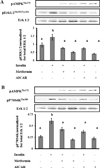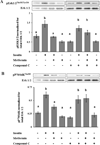Metformin: direct inhibition of rat ovarian theca-interstitial cell proliferation
- PMID: 22608319
- PMCID: PMC3389190
- DOI: 10.1016/j.fertnstert.2012.04.010
Metformin: direct inhibition of rat ovarian theca-interstitial cell proliferation
Abstract
Objective: To determine whether metformin has direct effects on ovarian theca-interstitial (T-I) cell proliferation through activation of adenosine monophosphate-activated protein kinase (AMPK).
Design: In vitro experimental study.
Setting: Academic medical center laboratory.
Animal(s): Immature Sprague-Dawley female rats.
Intervention(s): Ovarian T-I cells were isolated, purified, and cultured in the absence (control) or presence of insulin (1 μg/mL) with or without metformin or other activators/inhibitors of AMPK (AICAR, compound C).
Main outcome measure(s): Proliferation assessed by determination of expression levels of proteins involved in cell cycle progression, cyclin D3, and cyclin-dependent kinase 4 (CDK4) with Western blot analysis, and determination of DNA synthesis with bromodeoxyuridine (BrdU) incorporation assay; activation of AMPK, Erk1/2, and S6K1 determined by Western blot analysis with the use of antibodies specific for the phosphorylated (activated) forms.
Result(s): Metformin inhibited insulin-induced ovarian T-I cell proliferation and the up-regulation of the cell cycle regulatory proteins, cyclin D3 and CDK4. Metformin independently activated AMPK in a dose-dependent manner. Treatment with metformin inhibited insulin-induced activation of Erk1/2 and S6K1. This effect was reversed with the addition of compound C, a known AMPK inhibitor.
Conclusion(s): Metformin directly inhibits proliferation of ovarian T-I cells via an AMPK-dependent mechanism. These findings further validate the potential benefits of metformin in the treatment of conditions associated with hyperinsulinemia and excessive growth of ovarian T-I cells (such as polycystic ovary syndrome).
Copyright © 2012 American Society for Reproductive Medicine. Published by Elsevier Inc. All rights reserved.
Figures




References
-
- Asuncion M, Calvo RM, San Millan JL, Sancho J, Avila S, Escobar-Morreale HF. A prospective study of the prevalence of the polycystic ovary syndrome in unselected Caucasian women from Spain. J Clin Endocrinol Metab. 2000;85:2434–2438. - PubMed
-
- Knochenhauer ES, Key TJ, Kahsar-Miller M, Waggoner W, Boots LR, Azziz R. Prevalence of the polycystic ovary syndrome in unselected black and white women of the southeastern United States: a prospective study. J Clin Endocrinol Metab. 1998;83:3078–3082. - PubMed
-
- Adams J, Franks S, Polson DW, Mason HD, Abdulwahid N, Tucker M, et al. Multifollicular ovaries: clinical and endocrine features and response to pulsatile gonadotropin releasing hormone. Lancet. 1985;326:1375–1379. - PubMed
-
- Longacre TA, Gilks CB. Nonneoplastic Lesions of the Ovary. In: Nucci MR, Oliva E, editors. Gynecologic Pathology, 1st ed. Orlando, Florida: Churchill Livingstone; 2009. pp. 367–391.
-
- Gilling-Smith C, Willis DS, Beard RW, Franks S. Hypersecretion of androstenedione by isolated thecal cells from polycystic ovaries. J Clin Endocrinol Metab. 1994;79:1158–1165. - PubMed
Publication types
MeSH terms
Substances
Grants and funding
LinkOut - more resources
Full Text Sources
Miscellaneous

